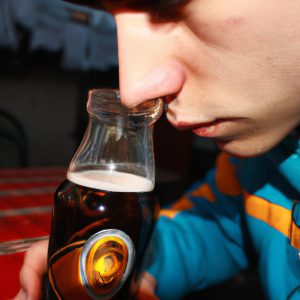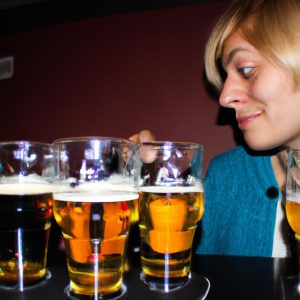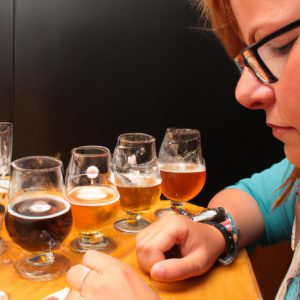Temperature: Enhancing Beer Tasting Techniques with Ideal Serving Conditions

The enjoyment of beer is not solely determined by its flavor and ingredients, but also by the temperature at which it is served. The impact of serving temperature on beer tasting experiences has long been a topic of interest among enthusiasts and researchers alike. For instance, imagine two individuals attending a beer tasting event where they are offered samples of the same craft beer. One person receives their sample chilled to perfection, while the other receives theirs at room temperature. Despite having identical beers in front of them, their perceptions and overall satisfaction with the taste may differ significantly due to variations in serving conditions.
Understanding the relationship between serving temperature and beer tasting techniques can greatly enhance one’s appreciation for this beloved beverage. Research suggests that different styles of beer have distinct optimal serving temperatures that bring out their unique characteristics and flavors. Moreover, variations in temperature influence various sensory aspects such as aroma, carbonation levels, mouthfeel, and aftertaste perception. By exploring ideal serving conditions for different types of beers, we can unlock new dimensions of complexity and depth within each sip, elevating our beer tasting experience to unprecedented heights.
Understanding the science behind temperature and beer tasting
Understanding the Science Behind Temperature and Beer Tasting
Imagine yourself sitting at a local brewery, eagerly awaiting the arrival of your freshly poured pint. As you take that first sip, you notice an explosion of flavors dancing on your palate – hints of caramel, citrus, and even a subtle hop bitterness. But have you ever wondered why certain beers taste better at specific temperatures? The answer lies in the delicate interplay between temperature and our sensory perception.
Temperature plays a crucial role in enhancing or diminishing the flavor profile of beer. For example, let’s consider a hypothetical scenario where two identical bottles of craft IPA are served side by side, but at different temperatures. One bottle is chilled to perfection at 45°F (7°C), while the other remains unrefrigerated at room temperature around 70°F (21°C). Upon tasting both samples, it becomes evident that the colder brew highlights crisp hoppy notes with refreshing clarity, whereas the warmer one mutes these flavors and emphasizes malty sweetness instead.
To truly appreciate how temperature affects beer tasting, it is essential to understand its impact on three key aspects: aroma release, carbonation levels, and overall mouthfeel. Firstly, lower temperatures tend to suppress aromas due to reduced volatility of aromatic compounds. This explains why some beers may appear less fragrant when served too cold. Secondly, excessive chilling can inhibit proper carbon dioxide release within the liquid matrix, resulting in a flat-tasting beverage lacking effervescence. Lastly, varying temperatures influence viscosity and texture perception; certain styles benefit from higher temperatures which enhance body and richness.
Consider this four-item bullet point list as we delve deeper into the relationship between temperature and beer tasting:
- Aroma intensity can be heightened or diminished based on serving temperature.
- Carbonation levels affect perceived freshness and mouthfeel.
- Different beer styles exhibit distinct optimal temperature ranges for maximum enjoyment.
- Understanding ideal serving conditions enhances appreciation for diverse beer profiles.
Now, let us explore the complex interplay between temperature and beer tasting further by examining a three-column table that showcases how different styles of beer respond to varying temperatures:
| Beer Style | Ideal Temperature Range (°F / °C) | Flavor Characteristics |
|---|---|---|
| Pale Ale | 45-50°F (7-10°C) | Hop bitterness, citrus notes |
| Stout | 55-60°F (13-16°C) | Roasty maltiness, chocolate |
| Wheat Beer | 40-45°F (4-7°C) | Banana, clove-like esters |
By understanding these nuances, we can better appreciate the intricate relationship between serving temperature and beer flavors. In our next section, we will delve into identifying the ideal temperature range for different beer styles without compromising taste or experience.
(Note: Transition sentence to subsequent section) Exploring the ideal temperature range for various beer styles allows us to optimize sensory enjoyment while unlocking the full potential of each brew.
Identifying the ideal temperature range for different beer styles
Understanding the science behind temperature and its impact on beer tasting is crucial for enhancing your overall experience. Let’s explore the ideal serving conditions, which can significantly influence the taste of different beer styles.
Imagine this scenario: you are at a local brewery, eager to try their renowned IPA. The bartender serves you two glasses of the same IPA—one chilled and one at room temperature. As you take your first sip from the chilled glass, you notice the hop bitterness is subdued, making it easier to appreciate the malt sweetness. Conversely, when sipping from the warmer glass, the hop flavors become more pronounced and complex. This example highlights how temperature affects our perception of flavor profiles in beers.
To optimize your beer tasting experience, consider these factors related to serving temperatures:
- Ideal range: Different beer styles have varying optimal serving temperatures that allow their unique characteristics to shine through. For instance, light lagers and pilsners tend to be best enjoyed between 38°F (3°C) and 45°F (7°C), while stouts and porters often exhibit their full complexity around 50°F (10°C) to 55°F (13°C). Referencing style-specific guidelines or speaking with knowledgeable experts will help ensure you serve each beer within its recommended range.
- Temperature stability: Maintaining a consistent temperature throughout consumption is essential as fluctuations can alter flavor perceptions. Investing in well-insulated glassware or utilizing specialized chilling devices like koozies or sleeve wraps can aid in preserving desired temperatures during extended drinking sessions.
- Gradual warming: Some high-alcohol beers benefit from gradual warming as they’re consumed. Consider starting with slightly lower initial serving temperatures for such brews then allowing them to slowly rise over time—this way, more intricate aromas and flavors develop progressively.
Emphasizing the importance of temperature control when enjoying beer elevates not only your personal enjoyment but also enhances appreciation for craftsmanship among fellow enthusiasts. To further illustrate the relationship between serving temperature and beer styles, consider this table:
| Beer Style | Optimal Serving Temperature Range |
|---|---|
| Light Lager | 38°F – 45°F (3°C – 7°C) |
| IPA | 40°F – 50°F (4°C – 10°C) |
| Stout | 50°F – 55°F (10°C – 13°C) |
| Belgian Tripel | 45°F – 52°F (7°C – 11°C) |
As we delve deeper into our exploration of the impact of temperature on aroma and flavor perception, it becomes evident that temperature is just one piece of the puzzle. By considering these factors and following style-specific guidelines, you can unlock a world of diverse taste experiences.
In the subsequent section, we will explore how different temperatures influence the aromatic elements in beers and unravel the intricate interplay between temperature and flavor perception.
Exploring the impact of temperature on aroma and flavor perception
Building upon our understanding of the ideal temperature range for different beer styles, let us now delve into how temperature affects aroma and flavor perception. To illustrate this concept, consider a hypothetical scenario where two individuals are tasting an IPA: one served at room temperature and the other chilled to the recommended serving temperature.
Aroma plays a crucial role in beer appreciation as it stimulates our olfactory senses and sets the stage for what we can expect from each sip. In the case study mentioned earlier, the individual presented with a room-temperature IPA experienced muted aromas compared to their counterpart who enjoyed a properly chilled version. The cold temperature helped preserve delicate hop oils, allowing them to release their enticing citrus and pine notes more effectively. This highlights that by not adhering to optimal serving temperatures, one may miss out on fully experiencing a beer’s intended bouquet.
Moving beyond aroma, flavor perception is another aspect influenced by temperature variations. When sipping on the room-temperature IPA, our hypothetical taster found that its bitterness was overpowering and unbalanced due to heightened alcohol presence. Conversely, when enjoying the chilled IPA within its suggested range, they discovered a harmonious blend of malt sweetness and hop bitterness, resulting in a more enjoyable drinking experience overall. This reinforces the importance of considering serving temperatures as it directly impacts how flavors interact on our palates.
To further emphasize the significance of proper chilling and storing techniques in maintaining beer quality and enhancing taste experiences:
- Chilling beers too much can dull their flavors and aromas.
- Storing beers upright helps prevent oxidation through minimizing contact with oxygen.
- Avoid exposing beers to rapid or drastic temperature fluctuations.
- Aim to serve beers at their respective recommended temperatures.
Table showcasing examples of recommended serving temperatures for popular beer styles:
| Beer Style | Recommended Serving Temperature |
|---|---|
| Pilsner | 38-42°F (3-6°C) |
| Pale Ale | 40-45°F (4-7°C) |
| Stout | 50-55°F (10-13°C) |
| Wheat Beer | 44-48°F (6-9°C) |
By understanding the impact of temperature on aroma and flavor perception, we can appreciate how proper serving conditions contribute to an enhanced beer tasting experience. As we now turn our attention towards tips for properly chilling and storing beer, let us explore practical steps to ensure that every sip is enjoyed to its fullest potential.
Tips for properly chilling and storing beer
Exploring the impact of temperature on aroma and flavor perception has shed light on the critical role it plays in enhancing beer tasting experiences. By understanding how different temperatures can affect the nuances of a beer’s profile, enthusiasts can ensure that they are enjoying their brews to their fullest potential. To further optimize these experiences, it is essential to consider the ideal serving conditions for beer.
Consider a hypothetical scenario where two individuals are sampling an IPA. The first person pours the beer directly from the refrigerator at around 4°C (39°F), while the second individual allows it to warm up slightly before pouring, resulting in a serving temperature of approximately 10°C (50°F). As they take their first sips, both notice significant differences in taste and aroma profiles. The cooler beer displays more subdued flavors and aromas, with bitterness being less pronounced. In contrast, the warmer sample presents a fuller range of flavors and aromas, allowing for better detection of hop characteristics such as citrus or floral notes.
To achieve optimal serving conditions for beer, several factors should be taken into account:
-
Ideal Temperatures: Different styles of beers have varying recommended serving temperatures. While lighter lagers may benefit from colder temperatures ranging between 3-7°C (37-45°F), complex ales might require slightly higher ranges of 8-12°C (46-54°F) to fully express their diverse flavors.
-
Glassware Selection: Choosing appropriate glassware can enhance not only visual appeal but also temperature maintenance during consumption. The shape and thickness of glassware influence heat transfer rates and insulation properties, ensuring that beers retain their desired temperatures throughout drinking sessions.
-
Serving Duration: It is important to consume beer promptly after pouring when served at its optimal temperature range. Prolonged exposure to ambient temperatures can cause fluctuations that diminish flavor profiles over time.
-
External Factors: Environmental surroundings can significantly impact serving conditions. Air conditioning or heating, direct sunlight exposure, and even humidity levels can influence the rate at which beer warms or cools. Therefore, it is advisable to consider these external factors when aiming for ideal serving conditions.
To emphasize the significance of temperature in beer tasting experiences, let us explore a table showcasing how different temperatures impact the sensory aspects of two popular beer styles:
| Temperature (°C) | Lager | Stout |
|---|---|---|
| 3-5 | Crisp body | Chilled smoothness |
| 8-10 | Full flavors | Rich chocolatey aroma |
| 12-14 | Refreshing finish | Roasted malt complexity |
Understanding and implementing these recommendations will undoubtedly enhance the overall enjoyment of beer. Moving forward, we will delve into another crucial aspect that contributes to maintaining optimal beer temperature: the role of glassware.
[Transition] Now, let us explore how selecting appropriate glassware further enhances the experience by aiding in temperature maintenance while ensuring consistent flavor profiles throughout consumption.
The role of glassware in maintaining optimal beer temperature
Enhancing Beer Tasting Techniques with Ideal Serving Conditions
Transitioning from our previous discussion on properly chilling and storing beer, it is important to understand the role of glassware in maintaining optimal beer temperature. The choice of glassware can significantly impact the experience and enjoyment of a beer, as different types of glasses are designed to enhance specific characteristics. Let’s explore how selecting the right glassware can contribute to an enhanced tasting experience.
Imagine you have just poured your favorite IPA into two different glasses: a standard pint glass and a tulip-shaped glass. As you take a sip from each, you notice that the aroma and flavor profiles differ slightly between the two vessels. This scenario exemplifies how glass shape affects not only visual presentation but also taste perception. By using appropriate glassware for each beer style, one can amplify its unique attributes.
To fully appreciate the nuances of beer flavors while ensuring ideal serving conditions, consider these key factors when choosing glassware:
- Shape: Different glass shapes promote varying levels of carbonation release and aromatics concentration.
- Rim Width: A wider rim allows for better air circulation during sipping, enhancing both aroma detection and overall taste experience.
- Material: Glass or crystal materials provide clarity, allowing drinkers to visually appreciate color variations within their beer selections.
- Capacity: Glass size should be matched to beer styles; smaller glasses help preserve carbonation levels in delicate beers like Belgian lambics, whereas larger glasses accommodate aromatic hop-forward brews such as IPAs.
To illustrate further differences among popular glassware choices for various beer styles, refer to the following table:
| Pint Glass | Tulip-Shaped Glass | Snifter | |
|---|---|---|---|
| Recommended | Pale Ale | Belgian-style Beers | Barrel-Aged Stouts |
| Characteristics | Wide opening | Flared lip | Wide bowl |
| Tapered mouth |
By employing appropriate glassware and considering the key factors mentioned above, beer enthusiasts can optimize their tasting experience by accentuating specific flavors and aromas. Experimenting with different glasses allows for a deeper understanding of how temperature interacts with various styles, ultimately enhancing the overall enjoyment of each brew.
Now that we have explored the importance of glassware in maintaining optimal beer temperature, let us delve into experimenting with temperature to further enhance your beer tasting experience.
Experimenting with temperature to enhance your beer tasting experience
Enhancing Beer Tasting Techniques with Ideal Serving Conditions
The role of glassware in maintaining optimal beer temperature has been explored extensively. Now, let us delve into the realm of experimenting with temperature to further enhance your beer tasting experience. Imagine a scenario where you are hosting a beer tasting event and want to impress your guests with an array of flavors and aromas. By serving different styles of beer at their ideal temperatures, you can truly elevate the sensory experience for everyone involved.
To begin, it is crucial to understand that each style of beer requires a specific temperature range for its flavors and aromas to shine. For example, a light lager or pilsner should be served colder (around 38-45°F) to highlight its crispness and refreshing qualities. On the other hand, darker beers like stouts or porters benefit from slightly warmer temperatures (around 50-55°F), as this allows their rich maltiness and complex flavors to develop fully.
Experimenting with temperature during a tasting session can provide valuable insights into how certain elements within a beer profile change under varying conditions. Here are some key factors to consider when exploring the impact of temperature on flavor perception:
- Mouthfeel: Temperature affects the viscosity and overall texture of beer, influencing how it feels on the palate.
- Aroma intensity: Warmer temperatures tend to release more volatile compounds, intensifying the aroma experience.
- Flavor balance: Different components such as hop bitterness or sweetness may become more pronounced or subdued depending on the serving temperature.
- Carbonation levels: Temperature influences carbon dioxide solubility, affecting both visual appearance and perceived effervescence.
Let’s take a closer look at how these variables interact by examining the following table:
| Style | Ideal Serving Temperature Range (°F) | Key Flavor/Aroma Notes |
|---|---|---|
| Light Lager | 38-45 | Crisp, clean, and refreshing with delicate malt sweetness |
| India Pale Ale | 45-50 | Hop-forward with citrusy or piney aromas and a balanced bitterness |
| Belgian Tripel | 50-55 | Complex fruity esters complemented by spicy phenols and a slightly sweet finish |
| Imperial Stout | 55-60 | Rich roasted malt flavors, dark chocolate notes, hints of coffee and dried fruit complexity |
By experimenting with beer temperatures within these recommended ranges, you can unlock the full potential of each style’s unique characteristics. The interplay between temperature and flavor is an exciting journey that allows for personal exploration and discovery.
In summary, understanding how different serving temperatures impact the sensory aspects of beer tasting provides valuable insights into enhancing your overall enjoyment. By considering variables such as mouthfeel, aroma intensity, flavor balance, and carbonation levels while experimenting with temperature, you can create memorable experiences for yourself and your guests during any beer tasting event. So next time you reach for a pint, take a moment to consider the ideal serving conditions that will maximize your appreciation of its distinct qualities.



